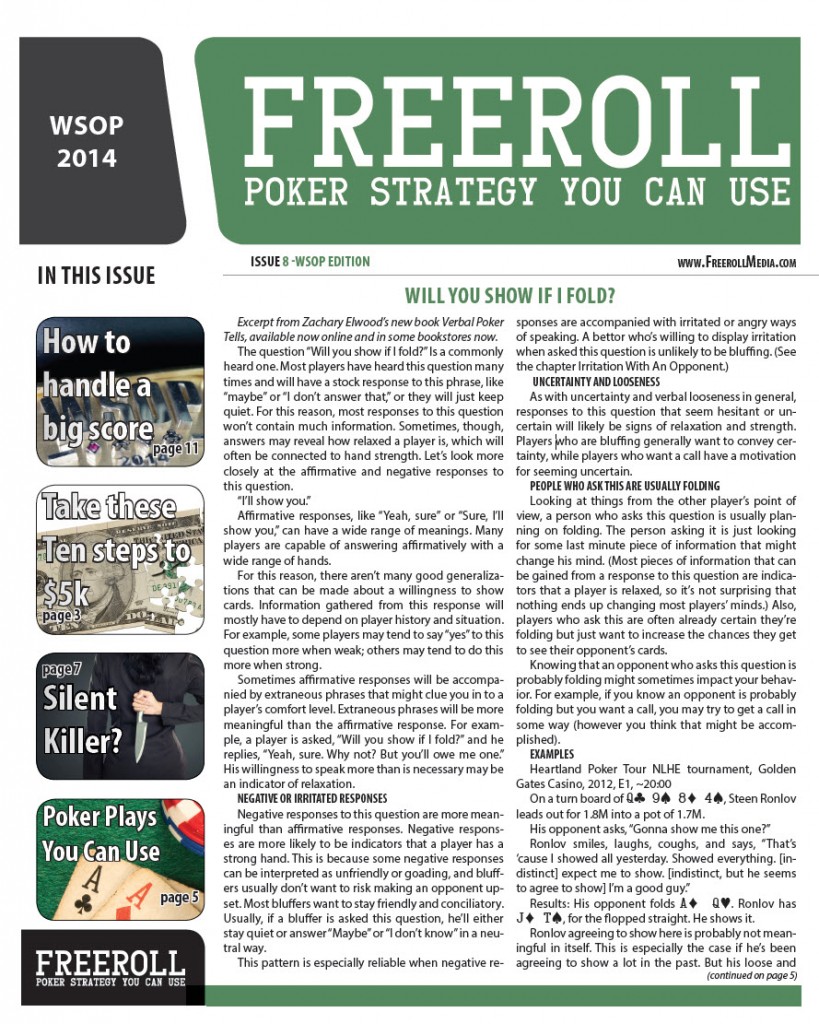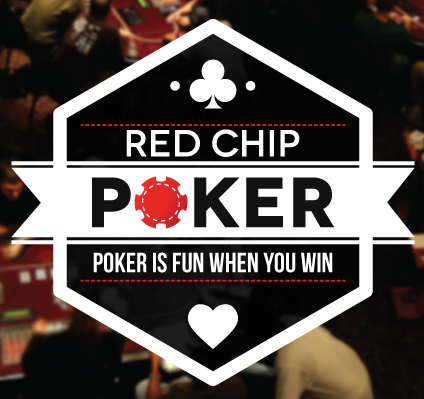Easy Game: Chapter Three: Preflop Hand Ranges and Postflop Equities
- By Andrew Seidman
- January 20, 2014
- Comments Off on Easy Game: Chapter Three: Preflop Hand Ranges and Postflop Equities
 Preflop is undoubtedly the easiest street to play. The variables are greatly reduced—only two cards per person are in play. Unlike postflop where situations become extremely complex and difficult, preflop is easiest to deal with. Yet every student I’ve ever coached has begun with one major preflop leak—they’re not thinking about postflop. To the average poker thinker, preflop is a vacuum in which we can raise K2o on the button because our hand is stronger than the range of the blinds.
Preflop is undoubtedly the easiest street to play. The variables are greatly reduced—only two cards per person are in play. Unlike postflop where situations become extremely complex and difficult, preflop is easiest to deal with. Yet every student I’ve ever coached has begun with one major preflop leak—they’re not thinking about postflop. To the average poker thinker, preflop is a vacuum in which we can raise K2o on the button because our hand is stronger than the range of the blinds.
How about this: If preflop were a vacuum, it would be profitable to raise 100% of your hands on the button. The dead money from when the blinds fold easily compensates for raising 72o. So, why don’t we raise 100% on the button? Oh that’s right… 72o is terrible postflop. K2o isn’t too far behind.*
One of the most common requests I hear is for help with won-money-without-showdown stats. The difficulty most players have with making money without going to showdown stems from their inability to play a well-formulated preflop game that is cohesive with their overall postflop strategy. There is a gap between their preflop plan and their postflop plan. In short, they’re not thinking about equity. Let’s explain.
We hold K8o on the button. Our initial thought is to raise because our range is ahead of the blinds and we can collect dead money. So let’s say we raise and the big blind calls. The flop comes down 9♠7♦3♣. The blind checks, we make a standard c-bet, and the blind calls. The turn card is the 2♠. The blind checks again. Boy-oh-boy do we have a conundrum. If we check it back, we’ll inevitably go to showdown with a weak hand and we’ll lose a decent pot. Seems pretty weak on our part. Or, we could bet… but the turn card isn’t scary and he’s unlikely to fold anything he called the flop with. Betting is often overly aggressive chip-spewy. The real problem with the postflop spot starts all the way back preflop. We chose a hand with poor postflop equity and thus we walk into unprofitable spots—situations where there’s simply nothing we can do right. There’s an easy solution though: choose hands that have good postflop equity.

What kind of cards are these?
Suited cards are a good place to start—they have great postflop equity. When I say this, most people’s immediate reaction is to tell me that suited cards only make a flush a small percentage of the time. That’s true, but let’s think about it in terms of equity:
On the left we have A♠6♠. On the right we have A♠6♦. We raise the button preflop, and the big blind calls again. The flop comes down 9♠7♠3♠. With A♠6♠ we have 100% equity, compared with about 50% with A♠6♦. About a 50% equity differential. That’s significant.
But come on, how often do we really flop a flush anyway? Agreed… let’s change the flop then—9♠7♠3♥. On A♠6♠ now we have 50% equity, compared with about 15% on A♠6♦. A 35% differential… that’s significant as well.
Most importantly, though, let’s consider a flop of 9♠7♦3♣. We bet and are called. The turn is a Q♠. A♠6♠ now has 12 outs. A6o has 3. Now, with the extra equity, we can stay aggressive. Thus, unlike A6o (where we have to choose between being weak or spewy) we can be appropriately aggressive with A6s. We’ll talk about this more in the next chapter.
High cards also have great equity. Let’s consider AQo. If we flop an A or Q, we usually have the best hand. However, on the vast majority of flops we miss, we are guaranteed six overcard outs. Often, that’s enough equity to continue aggression.
Connecting cards provide equity as well, although not as significantly as suited or high cards. They do have advantages, as straights are among the most disguised hands in poker, but they have plenty of disadvantages as well. If there is a flush draw on the board, a straight draw’s outs may be tainted. A straight draw has only 8 outs compared with a flush draw which has 9, or the nut flush draw which sits with 12. If we turn a straight draw, usually it’s a card that makes the board more coordinated and thus harder to stay aggressive on. An example would be JT on a K75Q board. The draw is nice, but we probably won’t be able to stay aggressive on such a strong turn card for our opponent’s range (KQ comes to mind).** A better example, though, might occur if the board was even lower and less frightening—say we hold JT on a 964r board and the turn is an 8. That’s a very difficult spot for us to continue aggression despite our hand’s strong equity.
In understanding all of this, we see that hands like A3s are extremely strong, mixing suited value, high card value, and connecting value. In fact, A2s-A5s are generally stronger than A6s-A9s, as the extra connecting card value usually more than compensates for the extra high card value (i.e. a six kicker isn’t much better than a 5 kicker, but a straight or straight draw is a whole lot better than nothing). Hands like 76s are strong as well, despite having no high card value. So are hands like KJo, despite having no suited value.
Aggression comes with a lot of advantages: we win bigger pots with our strong hands, we make our opponents fold the best hand, we collect dead money constantly, and it makes it difficult for our opponents to read our hand. Now that we know which cards put us in spots that let us stay aggressive, we can start to consider common spots where we have equity and want to keep applying pressure.
I have a lot to say about this chapter. Its basic premise remains incredibly important—you should be thinking about the postflop implications of your preflop play. For a beginning player, understanding which types of cards will give you equity is a vital step toward knowing what to do with that equity throughout the hand. In fact, on that level, this chapter is one of the most important in the entire book. However, there are a lot of statements that are easily argued against. Some things I’ve come to realize are just flat-out wrong.
First, I wrote this: “How about this: If preflop were a vacuum, it would be profitable to raise 100% of your hands on the button. The dead money from when the blinds fold would easily compensate for raising 72o. So, why don’t we raise 100% on the button? Oh that’s right… 72o is terrible postflop. K2o isn’t too far behind. I wish somebody would have slapped me in the face and said, “So don’t put any more money in postflop unless you make quads!” If opening 72o in a preflop vacuum is +EV, and the only problem is that we’re losing money by c-bet bluffing or paying off with a pair of sevens, then we should just open 72o and never c-bet or call any bets. It’s only moderately exaggerated to say that we should only put in money with quads– we’re making money from preflop only, so we can leave our commitment there. Obviously, if the flop is A22 we can feel fine value-betting. But, if the flop is A33, I’m probably just done.
Many of my students worry tremendously about their red lines (showing the amount of money they win without a showdown)–a great way to make your red-line go up is to steal more blinds. If you get called by somebody with a tight range, it’s okay to be done. If you’re opening 72o, they’ll have to loosen up a lot to make your preflop plays come anywhere near -EV. Of course, remember that in small stakes games you’re still going to make the bulk of your money from value-betting. This means your red line will go down (as your opponents call you more) but that your won-money-at-showdown will rise.
*there is an incredibly simple counter-argument to this that I’ll discuss in the addendum
**This would actually be a fine spot to stay aggressive against a regular—we can get almost everything but KQ to fold.


